

Robert Peckham (10 September 1785, Petersham, Massachusetts - 29 June 1877, Westminster, Massachusetts) was an American painter in the folk art tradition; known primarily for his portraits of children. He is often referred to as Deacon Peckham.


Robert Peckham (10 September 1785, Petersham, Massachusetts - 29 June 1877, Westminster, Massachusetts) was an American painter in the folk art tradition; known primarily for his portraits of children. He is often referred to as Deacon Peckham.
Nothing is known of his childhood. In 1813, he married Ruth Sawyer of Boston. To accommodate their growing family, which eventually numbered nine children, they settled in Westminster in 1821. Seven years later, he became a deacon at the local Congregational Church. [1] A man of strong moral beliefs, he was a promoter of temperance and an ardent opponent of slavery. According to one of his daughters, their home was a stop on the Underground Railroad. [2]
His outspoken advocacy on this issue caused a rift with his church, due to what they felt was overzealousness on his part and, when his wife died in 1842, he resigned his position; although he would continue to be called "Deacon" for the remainder of his life. He remarried the following year. In 1850, he was excommunicated by the church and he moved his family to Worcester. In 1863, following the Emancipation Proclamation, he was reinstated and returned to Westminster. [1] After that, his life appears to have been uneventful. [2]
His painting career began in 1809, when he took some lessons from Ethan Allen Greenwood, making him one of the few folk artists with any record of formal studies. [1] Later that year, he painted his first portrait. As with most amateur artists he was, at first, primarily a painter of signs and other workaday objects. In 1815, he and his brother Samuel placed an advertisement in the Hampshire Gazette , offering their services for "House, sign and ornamental painting. Also gilding, glazing and varnishing". [2]
By the 1830s and 1840s, he was producing brilliantly colored portraits of children in detailed domestic surroundings. An advertisement in the Massachusetts Spy from 1834 announced the opening of his portrait painting business. He charged ten dollars per portrait. These works offer a stark contrast to the darker paintings of adults he produced before and after that period, leading some to question if both groups of paintings are actually his. As with most folk artists, very few are signed, making attribution difficult. A portrait of the poet John Greenleaf Whittier is, however, attested to by Whittier himself, in somewhat dismissive terms. [2]

Visual art of the United States or American art is visual art made in the United States or by U.S. artists. Before colonization, there were many flourishing traditions of Native American art, and where the Spanish colonized Spanish Colonial architecture and the accompanying styles in other media were quickly in place. Early colonial art on the East Coast initially relied on artists from Europe, with John White the earliest example. In the late 18th and early 19th centuries, artists primarily painted portraits, and some landscapes in a style based mainly on English painting. Furniture-makers imitating English styles and similar craftsmen were also established in the major cities, but in the English colonies, locally made pottery remained resolutely utilitarian until the 19th century, with fancy products imported.
Joshua Johnson was an American painter from the Baltimore, Maryland area of African and European ancestry. Johnson is known for his naïve paintings of prominent Maryland residents.

Martin Johnson Heade was an American painter known for his salt marsh landscapes, seascapes, and depictions of tropical birds, as well as lotus blossoms and other still lifes. His painting style and subject matter, while derived from the romanticism of the time, are regarded by art historians as a significant departure from those of his peers.
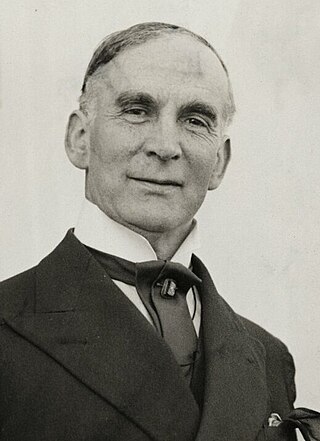
Francis Owen Salisbury CVO was an English artist who specialised in portraits, large canvases of historical and ceremonial events, stained glass and book illustration. In his heyday he made a fortune on both sides of the Atlantic and was known as "Britain's Painter Laureate". His art was steadfastly conservative and he was a vitriolic critic of Modern Art – particularly of his contemporaries Picasso, Chagall and Mondrian.

Gonzales Coques was a Flemish painter of portraits and history paintings. Because of his artistic proximity to and emulation with Anthony van Dyck he received the nickname de kleine van Dyck. Coques was also active as an art dealer.
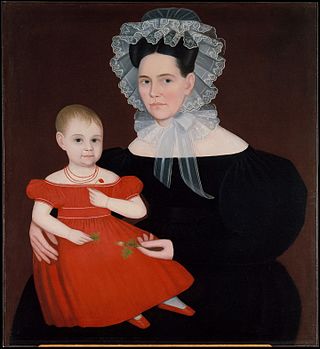
Ammi Phillips was a prolific American itinerant portrait painter active from the mid 1810s to the early 1860s in Connecticut, Massachusetts, and New York. His artwork is identified as folk art, primitive art, provincial art, and itinerant art without consensus among scholars, pointing to the enigmatic nature of his work and life. He is attributed to over eight hundred paintings, although only eleven are signed. While his paintings are formulaic in nature, Phillips paintings were under constant construction, evolving as he added or discarded what he found successful, while taking care to add personal details that spoke to the identity of those who hired him. He is most famous for his portraits of children in red, although children only account for ten percent of his entire body of work. The most well known of this series, Girl in Red Dress with Cat and Dog, would be sold for one million dollars, a first for folk art. His paintings hung mostly unidentified, spare for some recognition in the collections like those of Edward Duff Balken, for decades until his oeuvre was reconstructed by Barbara Holdridge and Larry Holdridge, collectors and students of American folk art, with the support of the art historian Mary Black. Ammi Phillip's body of work was expanded upon their discovery that the mysterious paintings of a "Kent Limner" and "Border Limner" were indeed his.

Jacob Eichholtz (1776–1842) was an early American painter, known primarily for his portraits in the Romantic Victorian tradition. Born in Lancaster, Pennsylvania in a family of prosperous Pennsylvania Germans, he spent most of his professional life in Philadelphia. A coppersmith by trade, he turned to painting and achieved both recognition and success despite being mainly self-taught as an artist. He is known to have painted over 800 portraits over the course of 35 years. Hundreds of his works are housed in art museums, historical societies, and private collections throughout the United States.
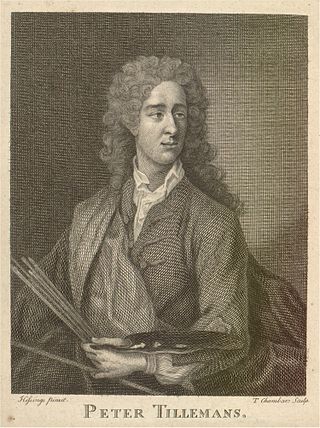
Peter Tillemans was a Flemish painter, best known for his works on sporting and topographical subjects. Alongside John Wootton and James Seymour, Tillemans was one of the founders of the English school of sporting painting.
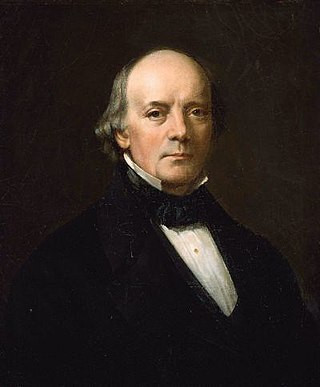
Harding's Gallery in Boston, Massachusetts, exhibited works by European and American artists in the 1830s-1840s. The building on School Street also housed a newspaper press; the Mercantile Library Association; the Boston Artists' Association; and artists' studios. The building's name derived from painter Chester Harding, who kept his studio there.
Ralph Nicholson Wornum (1812–1877) was a British artist, art historian and administrator. He was keeper and secretary of the National Gallery of London from 1855 until his death.
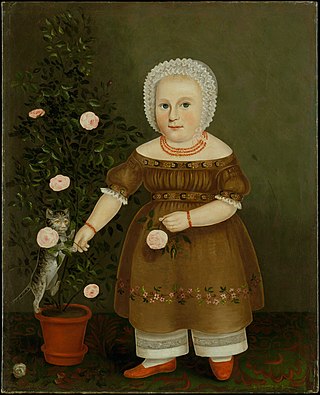
John Bradley was a British-born American artist who was active in the New York area in the 1830s and 1840s. He is primarily known for his portrait paintings, which are held in several North American museum collections.

Mary Blood Mellen was an American painter who was one of several individuals who studied under Fitz Henry Lane. Mellen is one of a number of women painters associated with the Hudson River School of artists in nineteenth-century New England. Her paintings often included landscapes and maritime images. Though she spent time in New York and Connecticut, Mellen lived primarily in Massachusetts, and many of her paintings find their source in the Massachusetts and Maine landscapes and seascapes. In 1840, she married the Rev. Charles W. Mellen, a Universalist minister at a number Massachusetts churches prior to his death in 1866.

William Valentine (1798-1849) was a portrait painter and daguerreotypist in Halifax, Nova Scotia.

Erastus Salisbury Field was an American folk art painter of portraits, landscapes, and history pictures.

Rufus Hathaway (1770–1822) was an American physician and folk art painter. He lived in southern Massachusetts, where he painted numerous portraits between 1790 and 1795. He later studied medicine and established himself as a doctor at Duxbury.

Samuel Addison Shute (1803–1836) and Ruth Whittier Shute (1803–1882) were a husband and wife team of itinerant portrait painters active in New England and New York State during the 1830s. Ruth Whittier Shute continued painting through the 1870s.

Joseph H. Davis was an itinerant American portrait painter. Over a period of only five years, from 1832 to 1837, he painted about 150 watercolor portraits of residents of Maine and New Hampshire. The body of work he left behind is highly regarded for its calligraphic line, miniaturizing delicacy, and decorative stylization. His pictures are in many important collections, including those of the American Folk Art Museum, the Metropolitan Museum of Art, the Museum of Fine Arts, Boston, the National Gallery of Art, the Terra Foundation for American Art and the Strawbery Banke museum in Portsmouth, New Hampshire.
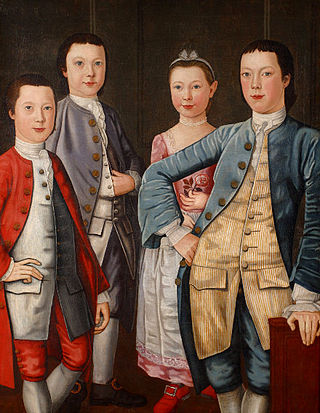
John Durand was a colonial American portraitist. With John Mare, Abraham Delanoy, and Lawrence Kilburn, he was one of a number of portraitists living and working in New York City during the 1760s.

Horace Bundy was an itinerant American portrait painter. He is generally classified as a folk artist, due to his lack of formal instruction.

Milton William Hopkins was an American portrait painter in the folk art tradition.